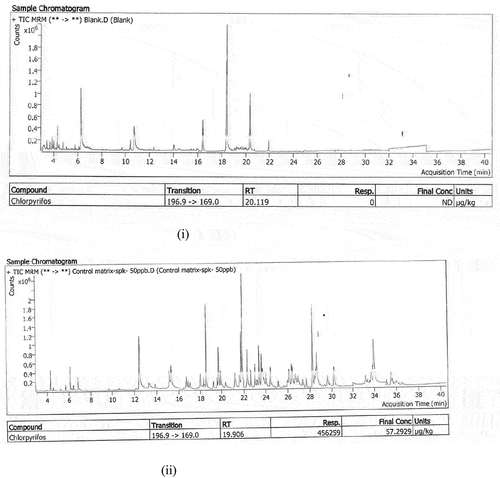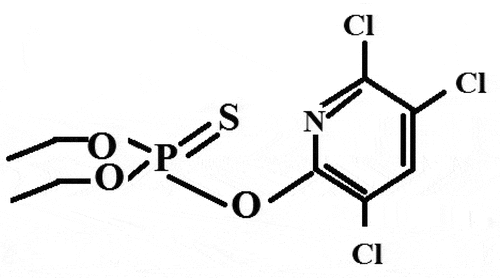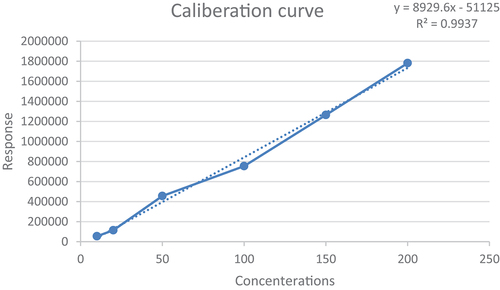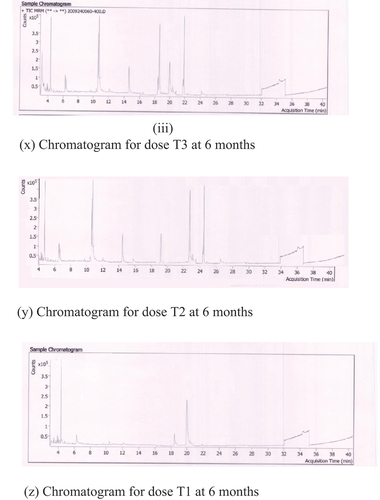Abstract
The present study was done to monitor the degradation pattern of chlorpyrifos on Golden Delicious apples in the Kashmir valley under storage conditions. The dissipation pattern was studied for three application rates of chlorpyrifos (Dursban 20 EC) by dipping the samples in T1 (first dose) 2 ml/1000 ml, T2 (second dose) 1 ml/1000 ml, and T3 (third dose) 0.5 ml/1000 ml. The initial deposit was found to be 40.62 µg/kg for T1, 37.23 µg/kg for T2, and 35.27 µg/kg for T3 on apple. The residue dissipated to about 2.53 µg/kg in T1, 2.32 µg/kg in T2, and 2.2 µg/kg in T3 after 300 days of application. The waiting period after proper risk assessment was calculated and was found to be 1.6 days for almost all application rates. The theoretical maximum residue contribution values were calculated, and, in relation to maximum permissible intake, it was found that chlorpyrifos poses a minimum health risk when consumed after 1.6 days in storage.
Keywords:
1. Introduction
Apple (Malus domestica Borkh) is a nutrient-laden fruit which is exceptionally high in numerous nutrients like vitamins C, E, and K (Apples., Citation2022). Apple also possesses numerous medicinal properties. Apple is the economical backbone of the Jammu and Kashmir and is grown in over an area of 1.61 lakh ha−1 which produces 16.47 lakh MT of apple (Anonymous Citation2014). However, it has been found that low production of apple in temperate areas is because of numerous reasons, one of which is various insect pests. The apple trees are in constant danger of pest attacks right from flower bloom till harvest; therefore, the use of pesticide for obtaining an ideal yield and utilising the tree to its maximum potential is necessary. Various pests that infect the tree include European red mite (Panonychus ulmi Koch) and San Jose scale (Quadraspidiotus perniciosus Comstock). These are considered to be the deadliest pests that reduce the yield to almost half of the original quantity (Ahmad & Ahmad, Citation2013). Numerous pesticides are thereby recommended, and chlorpyrifos is one of them [O, O-diethyl-O-(3,5,6-trichloro-2-pyridinyl) phosphonothioate] (Figure ). It is considered to be an excellent non-systemic insecticide for the control of pests of apple.
Chlorpyrifos is a non-systemic insecticide; the mode of action for the same includes ingestion, inhalation, and direct contact (Tomlin, Citation2006). Chlorpyrifos has a typical metabolite chlorpyrifos oxon which reacts with the enzyme acetylcholinesterase (AchE). This prevents the enzyme from performing hydrolysis of acetylcholine (Ach) in the synapse. AchE gets permanently inhibited by the chlorpyrifos which results in the high presence of acetylcholine between the neurons which make the neural transmission last longer and thus disturbs the normal rate of nerve transmission (Flaskos, Citation2012). In Kashmir, the growers use chlorpyrifos just before the harvest to prevent San Jose scale and European red mite. Although the use of the same is banned recently in India, the application of the same is still done to a very large extent as it is still recommended by numerous state agricultural agencies. Therefore, this practice may leave residues which can be extremely hazardous for human health. The presence of this residue is based on numerous factors like dosage applied, waiting period between post-harvest and pre-culinary, crop variety, and agro climatic conditions (Jyot et al., Citation2005). It must also be noted that Kashmiri apples are stored in cold storage for a very long time before they are exported to various places in the world. Since no published data were found on the dissipation pattern of chlorpyrifos in cold storage and how much waiting period must be given to the fruits before they are consumed, the present study was done to investigate the same in Kashmir.
2. Materials and methods
2.1. Chemicals and reagents
The chlorpyrifos reference standard (purity 99.5%) was purchased from Sigma-Aldrich, USA. A chlorpyrifos market formulation (Dursban 20 EC) obtained from M/S Premium sales agency, Srinagar, was used for dipping and spiking. Acetonitrile (HPLC grade) and acetic acid were purchased from HIMEDIA, India, and sorbents for QuEChERS analysis like primary–secondary amines (PSA), anhydrous magnesium sulphate, and sodium acetate were all purchased from Sigma-Aldrich, USA. All the reagents and sorbents were kept at 4°C or as directed by the manufacturer. Blanks before samples were also run to test the reagents for purity.
2.2. Preparation of standard solution
The stock standard solution of chlorpyrifos (1 mg/ml) was prepared in HPLC grade acetonitrile. The working solutions were required for constructing a calibration curve (10, 20, 50, 100, 150, and 200 µg/ml) from serial dilution with hexane. All standard solutions were stored at refrigerated conditions (4°C) before use.
2.3. Instruments
The detection of chlorpyrifos was done by gas chromatography–mass spectroscopy (Agilent 6890 N and 5973 N Single Quadrupole MS) equipped with nitrogen phosphorous detector (NPD and NPD+). The column used for the separation was RTX-5MSX-0.25 mm, and carrier gas used for elution was helium at 1 ml/min at a temperature of 100°C on hold for 1 min and then the temperature was reduced at 10°C for 1 min and gradually increased by gradient up to 320°C. This was then kept on hold for 7 min. Two microlitres were injected in the split-less mode. Mass spectroscopy was done at the capillary voltage of 3KV where ionisation mode was kept positive with a temperature of 400°C (desolvation). Oven temperature was 320°C. Quantitation ion m/z ratio was 97. The gas temperature was regulated at 800 l/h with a source temperature of 150°C. The total run time was that of 30 min. Data compilation and analysis were performed by Mass hunter Software under MRM mode. Simple probe homogeniser WiseTis® was used for homogenising the sample. For sample preparation, Eppendorf®5810 R centrifuge was used.
2.4. Sample preparation
This study was carried out on apple (var. Golden Delicious) at University of Kashmir, Hazratbal, during the autumn harvest season of 2020. The samples collected were from the local market base and were first tested for interferences. Interferences being found as negative, the samples were washed and dipped in the commercial formulation of chlorpyrifos. The formulation was diluted in the distilled water at the concentration of 2 ml/1000 ml (T1), 1 ml/1000 ml (T2), and 0.5 ml/1000 ml (T3). The samples were allowed to rest in the formulation for 2 h. The samples for 0 weeks (as soon as the solution dried up) were collected and analysed, while the rest of the samples were stored at 4°C for 10 months. The change in the residual concentration was monitored at regular intervals of 2, 4, 6, 8, and 10 months.
2.5. Processing of samples
Apple fruits were chopped with peel and pulp intact on a simple chopping board and blended in an electric blender with 1000 rpm. The samples were then homogenised in a homogeniser.
Pesticide residues were then extracted using QuEChERS method with dispersive clean-up.
About 15 g of homogenised sample was used during comminution and mixed with 6 g of anhydrous MgSO4 in a 15 ml centrifuge tube. 1.5 g of sodium acetate was used as a buffer and mixed with 15 ml of 1% acetic acid of ethyl acetate. The tubes were tightly closed and vigorously shaken for 1 min on a vortex mixer for 2 min. The samples were centrifuged at 1500 rcf for 1 min.
For d-SPE, 7 ml of supernatant was added to a centrifuge tube containing 150 mg anhydrous MgSO4 along with 50 mg of PSA. The tubes were shaken well for 2 min on a vortex mixer and then centrifuged for 1500 rcf for 1 min. About 1 ml of supernatant was collected using a micropipette and transferred to an autosampler vial of GC/MS
2.6. Degradation kinetics
The degradation kinetics of the pesticide residue in apples was obtained by residue concentration versus time graph. The degradation trend followed was that of first-order kinetics. This was validated by graphical representation of lnC against time. The degradation rate constant was calculated by Ct = Coe−kt, where Ct is the concentration of the pesticide at time t, Co is the initial concentration of the sample, and k is the rate constant in days.
Mean lifetime τ, half-life (t1/2), and decay constant λ were calculated using respective chemical equations and formulas which are N(t) = NO (1/2) t/t1/2, N(t) = NO e—t/ τ, and N(t) = NO e—λt
where No is the initial quantity (before storage), N(t) is the residual quantity at regular monitoring intervals after time t, τ is the mean lifetime, t1/2 is the half-life, and λ is the decay constant. Half-life was used to calculate the k value and in 2/k for each experiment (Wang et al., Citation2007). Waiting period was theoretically calculated by Hoskin’s (Citation1961) formula:
TMRL = (log K2—log tolerance)/K1
where
TMRL= Pre-harvest interval or the waiting period;
log K2 = log of initial deposit;
log tolerance = log of MRL;
K1 = slope of regression (Hoskin, Citation1961).
3. Results and discussion
A calibration curve with six chlorpyrifos concentrations was built (R2: 0.9937; Figure ). The limit of detection was found to be 0.01 mg/kg and the limit of quantification was found to be 0.02 mg/kg for chlorpyrifos in Golden Delicious apple. Method validation was carried out for apple samples by fortifying them with 10, 20, 50, 100, 150, and 200 µg/kg in triplicate and were extracted by the same method as described above. The recovery percentage was found to be commendable in the range of 81.43–91.97% which was calculated by
Recovery = concentration / fortification × 100.
Relative standard deviation was calculated in %RSD and ranged between 0.73% and 1.22% ().
Table 1. Recovery percentage of chlorpyrifos from Golden Delicious apple fruits
No correction factors were applied. The chromatograms for blank, fortified samples, and standard are shown in .
Figure 3. Chromatogram of chlorpyrifos: (i) Blank, (ii) standard, and (iii) samples.

The dissipation trend for chlorpyrifos is presented in . Average initial deposit of the pesticide was found to be 40.62 µg/kg, 37.23 µg/kg, and 35.27 µg/kg, respectively, in T1, T2, and T3 doses. After 60 days of storage at 4°C, the residues degraded substantially and reached 20.61 µg/kg, 18.67 µg/kg, and 17.63 µg/kg in three doses, respectively. On 120th day, the residues were found to be 10.155 µg/kg, 9.3 µg/kg, and 8.81 µg/kg with a percentage decrease of 75.0%, 50.19%, and 50.02%, respectively.
Table 2. Dissipation trend in chlorpyrifos in Golden Delicious apples
After 300 days, the percentage reduction of the residues was found to be 93.77%, 99.99%, and 99.99% in three doses, respectively. Residual concentration versus time relationship can be seen in .
Figure 4. (a) Graph of residue dissipation vs. time following first-order kinetics for dose T1. (b) Graph of residue dissipation vs. time following first-order kinetics for dose T2. (c) Graph of residue dissipation vs. time following first-order kinetics for dose T3.

The trend in the reduction of the pesticide residue analysis can be observed by the exponential decrease in the residual concentrations as it follows the first-order rate of kinetics. The kinetic equation followed is that of Ct = Coe−kt, where concentration (C) and time (t) are found to be as in . Data for all the three doses were subjected to statistical analysis, and calculation of half-life, decay percentage, and mean lifetime (US EPA, Citation2022) were calculated as given in . Therefore, for the safety of consumers, the waiting period was found to be 1.6 days for chlorpyrifos-treated apple under storage in Kashmir valley.
It was observed by Kim et al. (icrierCitation2003) that the half-life period of chlorpyrifos was 9.3 days when dissipated as per first-order kinetic equation. The same was reported by Chauhan et al. (Citation2011) when they studied the dissipation trend of okra where half-life was found to be higher in double-dose treatment.
4. Risk assessment
The risk assessment with respect to chlorpyrifos dissipation in storage was calculated by evaluating dietary exposure with maximum permissible intake (MPI). The prescribed acceptable daily intake (ADI) for chlorpyrifos is 0.01 mg/kg per body weight per day (EPA, Citation1984). Considering the average weight of an individual as 55 kg, the MPI was found to be 0.55 mg/kg. On the basis of average per capita consumption of fruits and vegetables, an average of 80 g is consumed by the consumer per day (Mukherjee et al., Citation2021). The theoretical maximum residue contribution (TMRC) was found to be as stated in .
Table 3. Dissipation trend in chlorpyrifos in Golden Delicious apples
Table 4. Dissipation trend in chlorpyrifos in Golden Delicious apples
Table 5. Risk assessment for chlorpyrifos dose T1
Table 6. Risk assessment for chlorpyrifos dose T2
Table 7. Risk assessment for chlorpyrifos dose T3
Since the TMRC values decrease significantly after 1.66 days and are in below limit of detection after 300 days, the waiting period was thus found to be 1.6 days. This therefore imposes minimum health risk to the consumers if consumed after the waiting period of 1.6 days, thereby concluding that the persistence of chlorpyrifos is apparently low in apples.
5. Conclusion
QuEChERS (Quick, Easy, Cheap, Effective, Rugged, Safe) method of extraction was used for extraction of chlorpyrifos in the apple samples. The limit of detection was found to be 0.01 mg/kg and the limit of quantification was found to be 0.02 mg/kg for chlorpyrifos in Golden Delicious apple. The recovery percentage was found to be commendable in the range of 81.43–91.97%. After 300 days, the percentage reduction of the residues was found to be 93.77%, 99.99%, and 99.99% in three doses, respectively. The half-life was found to be 59.95 days for all the three doses. The trend in the reduction of the pesticide residue analysis can be observed by the exponential decrease in the residual concentrations as it followed the first-order rate of kinetics. Since the TMRC values decrease significantly after 1.6 days and are in below limit of detection after 300 days, the waiting period was thus found to be 1.6 days. This therefore imposes minimum health risk to the consumers if consumed after the waiting period of 1.6 days.
Acknowledgements
The first author holds I.C.M.R. (Indian Council of Medical Research) full-time PhD research fellowship on the topic researched under the able guidance of Dr. F.A. Masoodi.
Disclosure statement
No potential conflict of interest was reported by the authors.
Additional information
Funding
References
- Ahmad, N., & Ahmad, T. (2013). Fruits related problems and their management in Rajouri district of Jammu and Kashmir. Journal of the Humanities and Social Sciences, 12(2), 65–11 doi:http://dx.doi.org/10.9790/0837-1226575.
- Anonymous. (2014). District wise area and production of major horticultural crops in J&K state for the year 2013–2014. Directorate of horticulture Kashmir. http://hortikashmir.gov.in
- Chauhan, R. S., Kumari, B., & Kumari, B. (2011). Persistence and effect of processing on reduction of chlorpyrifos residues in okra fruits. Bulletin of Environment Contamination and Toxicology, 87(2), 198–201. https://doi.org/10.1007/s00128-011-0306-z
- EPA. (1984). Health and environmental effects profile for chlorpyrifos and chlorpyrifos methyl. US Environmental Protection Agency Washington DC EPA/600/x-84/331, NTISPB88161955. https://cfpub.epa.gov/ncea/risk/hhra/recordisplay.cfm?deid=48094
- Flaskos, J. (2012). The developmental neurotoxicity of organophosphorus insecticides: A direct role for the oxon metabolites. Toxicology Letters, 209(1), 86–93. https://doi.org/10.1016/j.toxlet.2011.11.026
- Hoskin, W. M. (1961). Mathematical treatment of the rate of loss of pesticide residues. FAO Plant Protection Bulletin, 9, 163–168.
- Jyot, G., Sahoo, S. K., Battu, R. S., Kang, B. K., & Singh, B. (2005). Dissipation of ethion on brinjal (Solanum melongena L.) under subtropical conditions at Ludhiana, Punjab, India. Bulletin of Environment Contamination and Toxicology, 75(6), 1094–1097. https://doi.org/10.1007/s00128-005-0861-2
- Kim, S. K., Park, J. H., Park, J. W., Lee, Y. D., Lee, K. S., & Kim, J. E. (2003). Residue levels of chlorpyrifos and chlorothalonil in apples at harvest. Korean Journal of Environmental Agriculture, 22(2), 130–136. http://koreascience.or.kr/article/JAKO200310737133157.page
- Mukherjee, A., Dutta, S., & Goyal, T. (2021). A snapshot of fruits and vegetables consumption, availability and implications for phytonutrient intake. icrier. Retrieved 16 February 2021, from http://icrier.org/pdf/India_Phytonutrient_Report_Ex_summary.pdf
- The Nutrition Source. 2022. Apples. https://www.hsph.harvard.edu/nutritionsource/food-features/apples/#:~:text=Source%20Of&text=One%20serving%2C%20or%20one%20medium,)%2C%20and%203%20grams%20fiber [Accessed 8 June 2022]
- Tomlin, C. D. S. (2006). The pesticide manual, a world compendium (14th ed., pp. 186–187). British Crop Protection Council.
- US EPA. 2022. Guidance to calculate representative half-life values and characterizing pesticide degradation | US EPA. <https://www.epa.gov/pesticide-science-and-assessing-pesticide-risks/guidance-calculate-representative-half-life-values> [Accessed 8 June 2022]
- Wang, S. L., Liu, F. M., Jin, S. H., & Jiang, S. R. (2007). Dissipation of propisochlor and residue analysis in rice, soil and water under field conditions. Food Control, 18(6), 731–735. https://doi.org/10.1016/j.foodcont.2006.03.009



